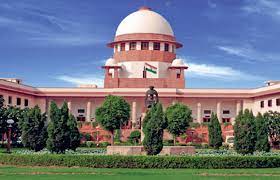
The Supreme Court on Tuesday referred a batch of pleas challenging the constitutional validity of the colonial-era sedition provision in the Indian Penal Code (IPC) to a constitution bench comprising a minimum of five judges.
A bench comprising Chief Justice D Y Chandrachud, Justice JB Pardiwala, and Justice Manoj Misra, rejected the Centre’s request to delay the reference to a larger bench, citing Parliament’s ongoing process of re-enacting the penal code’s provisions.
The bench has directed the Supreme Court registry to present the case documents to the Chief Justice for consideration on the administrative front, with the aim of forming a bench comprising “at least five judges.”
The bench led by the Chief Justice rejected the government’s request to postpone the hearing due to its plans to introduce new criminal laws. The Chief Justice noted that criminal legislation has a prospective effect and does not apply retrospectively. Therefore, if an act is classified as a crime in 2023, individuals who committed it before 2023 cannot be punished.
In May 2022, the apex court suspended the law and directed the Centre and states not to register any sedition cases under Section 124A of the Indian Penal Code (IPC), stating that it was not in line with the current social context. The court allowed for a reconsideration of this provision. All ongoing trials, appeals, and proceedings related to charges under Section 124A were put on hold, with adjudication proceeding only if courts were convinced that it would not prejudice the accused.
In the event of a new case being registered, affected parties could seek relief in court, despite the bench rejecting the Centre’s suggestion to have a superintendent of police monitor the registration of FIRs for sedition.
Section 124A of the IPC prescribes a maximum life sentence for inciting “disaffection towards the government.” It was added to the penal code in 1890, 57 years before India’s independence and nearly 30 years after the IPC’s inception. During the pre-independence era, this provision was used against freedom fighters, including Mahatma Gandhi and Bal Gangadhar Tilak.
Between 2015 and 2020, 356 sedition cases were registered under Section 124A, resulting in the arrest of 548 individuals, as per data from the National Crime Records Bureau (NCRB). However, only 12 people arrested in seven sedition cases were convicted during this six-year period. In 1962, the Supreme Court upheld the validity of the law while attempting to narrow its scope to prevent misuse. Section 124A of the IPC states that anyone who “by words, either spoken or written, or by signs, or by visible representation, or otherwise, brings or attempts to bring into hatred or contempt, or excites or attempts to excite disaffection towards, the government established by law in India, shall be punished with imprisonment for life, to which fine may be added, or with imprisonment which may extend to three years, to which fine may be added, or with fine.”
The Evolution of India’s Sedition Law
In 1837, Thomas Macaulay, a prominent British administrator, introduced the concept of sedition through a draft proposal. His involvement in Indian affairs began in 1834 when he accepted a role on the newly established Supreme Council of India. Macaulay saw this as an opportunity to secure compensation that would enable him to acquire a skill that could benefit him throughout his life.
During his tenure, he developed a comprehensive code of reforms that would eventually evolve into the Indian Penal Code (IPC), a cornerstone of Indian criminal law. Within this early framework, the sedition provision found its place, making it one of the first laws implemented during the colonial era.
Inclusion of Sedition in the Indian Penal Code
Proviso 113 of the Criminal Code defined sedition as a criminal offense. The motivation behind its inclusion in the draft was the rise in dissent among Indian progressives who opposed the British colonial rulers.Suppression of Dissent
It’s essential to note that the sedition law was not the only tool employed by the British colonial administration to suppress the voices of Indian activists. Other laws, such as the Vernacular Press Act of 1878 (repealed in 1881), the Newspapers Act of 1908, and the Indian Press Act of 1910 (repealed in 1921), provided legal backing to the British government’s efforts to quell dissenting voices. However, for the purpose of this discussion, we will focus on the sedition law.
Definition in the Indian Penal Code
The Indian Penal Code defines sedition as follows:
“Whoever, by words, either spoken or written, or by signs, or by visible representation, or otherwise, brings or attempts to bring into hatred or contempt, or excites or attempts to excite disaffection towards, the Government established by law in India, shall be punished with imprisonment for life, to which a fine may be added, or with imprisonment which may extend to three years, to which fine may be added, or with fine.”
This definition continues to be a subject of debate and discussion in contemporary India, reflecting the complex legacy of sedition laws in the country.















